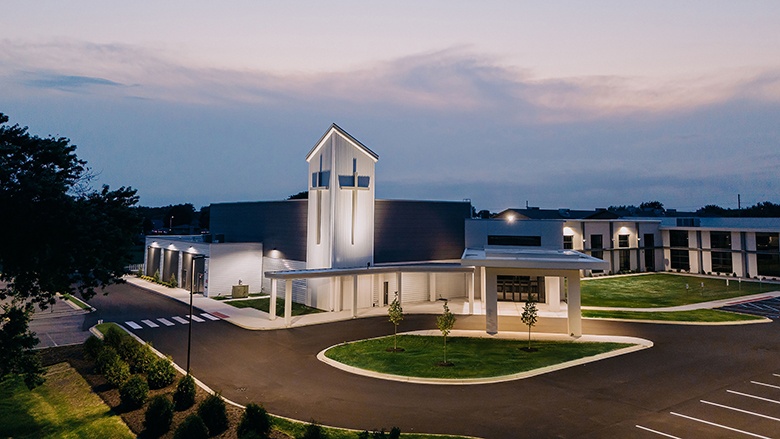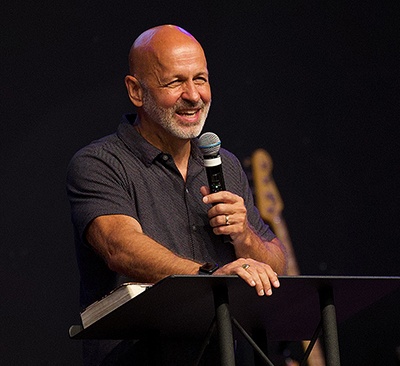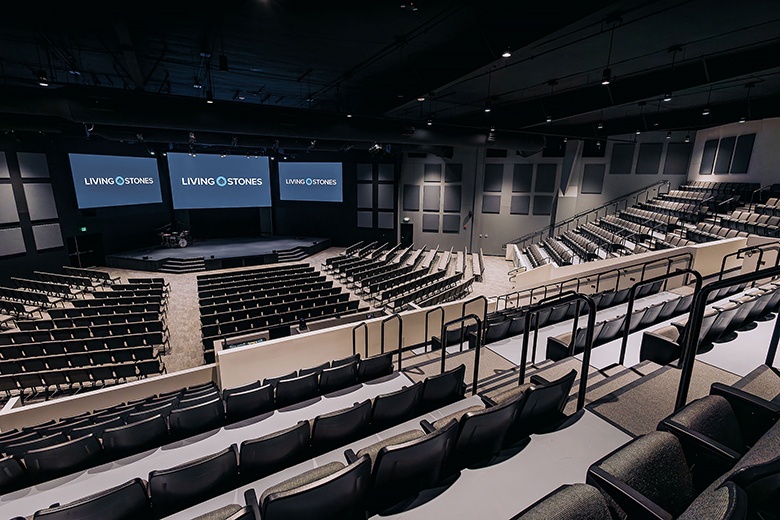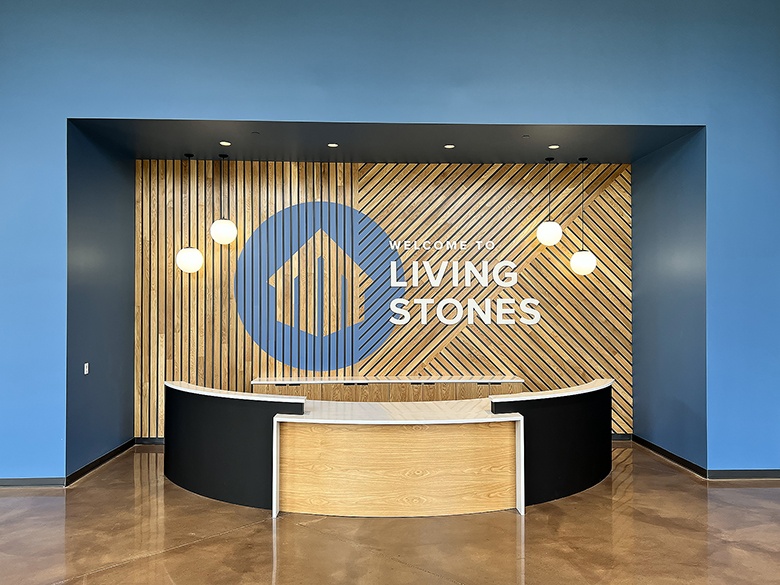
RON JOHNSON, JR. / PASTOR / LIVING STONES CHURCH / CROWN POINT, IND.
Ron Johnson, Jr., (literally) grew up in the church he now pastors. Today, 30+ years later, Living Stones is celebrating massive growth that came about in the unlikeliest of times.
By RaeAnn Slaybaugh
When Ron Johnson, Jr., was a child, his father — a teacher and football coach — began witnessing to his colleagues and friends, leading them to Christ. “They all had marriage troubles to go along with it, and the little church they were at the time didn’t really address that,” he recalls. “So, we opened up our home, ministering to marriages.”
It was October 1981.
Later, at 16, Johnson’s father made a point that struck a major chord with his son: “He told me, ’All these people have kids,’” Johnson remembers. “And that was my baptism in fire, for youth ministry.”
After finishing college and graduate school, Johnson returned home and joined his parents, serving as Living Stones’ youth pastor.
 A pivot point emerges
A pivot point emerges
For several years, Living Stones has experienced tremendous growth despite the odds. Notably, the spiritual growth that fueled the need for a significant physical expansion of the current facilities came about during COVID.
While the Indiana governor at the time mandated churches as non-essential, Johnson says he had a different perspective. After weeks of closure, he and his team committed to keeping the church open.
“After that, the Lord was sending us people in droves every week,” Johnson says.
Prior to the pandemic, Living Stones welcomed about 25 new members, quarterly, in its Starting Point program. For two years during COVID, this number grew to 100 new members per month.
Johnson introduced a third service, something the church has continued for four years, now. Even so, as he puts it, it “didn’t take a rocket scientist” to see that the church was out of space — particularly in its sanctuary, as well as in its children’s, administrative spaces and gathering spaces.
Enlisting wise counsel
As is usually the case with church projects, first things first: more sanctuary space.
“We knew immediately what we didn’t know: how to make that happen,” Johnson recalls. He enlisted a known partner for trusted guidance: Rodney James, president and founder of Master’s Plan Church Design & Construction. James led the church’s previous renovation project and has become a close friend of Johnson’s.

“He’s a high-integrity person, and he has never approached us as a business opportunity or as just a project; it’s like he’s on my team,” Johnson says. “Rodney loves the Lord, he loves the Church, and he wants everybody to win because he realizes it’s the Lord’s glory at stake, as well. I feel like I have a trusted advisor and team member who cares about the success of the project just as much as I do. And that’s so rare.”
Naturally, as a former pastor, James anticipated the path Johnson preferred to take: expanding the existing sanctuary — but that wasn’t an option. The shape and structure of the building, as well as the placement on the site for expansion, just didn’t make sense. What about adding a balcony? Again, no. Balconies are not conducive to the culture of intimacy that is so much a part of Living Stones. In addition, the structure of the building made this prohibitive. “We asked all the questions that everyone always asks,” Johnson remembers. “But Rodney just told us straight: ‘You’re not going to be able to expand your sanctuary.’”
So, a new 1,000-seat, 14,000-square-foot sanctuary and 4,500 square feet of added gathering space became priorities … but not the first orders of business, per se.
Interestingly, building a new parking lot on the outermost perimeter of the property was the nuts-and-bolts starting point.

Laying the foundation
“It does seem a little strange to start with parking, but we needed a new lot put in before we absolutely destroyed our existing one,” Johnson explains. “For about the first year of the project, it was nothing but moving dirt, getting everything graded, and then putting in the parking lot. Otherwise, we would’ve been in big trouble as far as [providing] parking spots for everybody.”
When finished, it was a decent walk from churchgoers’ vehicles to the existing sanctuary.
“I would always make jokes about the gravel and the dust. We made light of it and had fun,” Johnson says. “People get it: you either curse the dust or you just celebrate the growth. We chose to make this expansion fun, to make it a memory.”
With the new parking lot in place, teams started ripping out the old lot and building the new sanctuary in its place.
Placing a priority on kids
Aside from the new sanctuary, the church added 6,200 square feet of preschool/nursery space. After all, many among those droves of new members have children to care for.
Prior to the expansion, the two homeschool cooperatives that meet at the church — with about 200 children — were full to capacity. Additionally, the Sunday School ministry was so full that the church was having to turn children away. “Basically, we realized we needed to separate our nursery up through kindergarten and create more space for these kids closer to the new sanctuary,” Johnson says.

More office space, please(!)
Living Stones also added 5,200 square feet of administrative space — which, if you ask certain staff members, needed to happen yesterday.
“We had literally maxed out every square inch in our building, so we turned the women’s restroom into the receptionist’s office,” Johnson recalls, laughing. “I joked around with our receptionist: ‘Well, you do have four bathroom stalls in here. You could do private counseling or something, I’m sure?’”
Not surprisingly, she disagreed, and the stalls were removed. Now, all staff members are in one location, with not a sink, spout or stall in sight.

Stepping out in faith
In total, the church added more than 33,000 square feet of ministry space to its thriving campus.
At this point in the story, it might seem like the entire project went off without a hitch. But as any church leader attempting to build during COVID can attest, this would have been impossible.
Fortunately, as Johnson points out, Living Stones had wise counsel on their side among tremendous supply cost hikes.
At one point in the project — past the point of no return — steel costs rose by 30 percent, which translated to about $700,000. “That’s a big jump,” Johnson acknowledges. “But we told people, ‘You can choose to live in the American economy, or you can choose to live in the kingdom of God.’”
He adds: “I would tell people, ‘The Lord created all these problems for us, so it’s His responsibility to help us build a facility that can accommodate all these amazing people He’s sending us.’”
Johnson asked church members to do two things: first, to pray; second, to ask the Lord for his guidance. “And when He gave them a number, we asked them to simply obey, because that number might be bigger than they expected — but so is God. He wants to grow their faith, and he wants to wow them.”
True to form, there are many testimonies to this end, now. Some members made a three-year pledge and then received a raise at work or a promotion that was, to the dollar, the amount they pledged.
“When that happened, we just started having people share story after story after story,” he says. “It created a real sense of momentum. People got excited.”
As of press time, the church has collected nearly 97 percent of its pledges — more than $6.4 million in total. Leaders are on track to reach 100 percent within weeks.
“Attitude is big”
Having now led two major building projects — with both coming in under budget, even amid rising costs — Johnson encourages church pastors undergoing similar projects to “focus on the people, not the building.” In talking with a fellow pastor and friend recently whose church had been struck by a hurricane, necessitating a restoration project, he echoed this advice.
“He’s a little bit weary, but I suggested shifting the focus to what God’s doing in people’s lives,” Johnson says. “I told him, ‘Don’t let the dust, the discouragement, how many more months are left in the project — all of those things — suck the life out of you. Just love the people; care for the people and celebrate what God’s doing.”
Having faced as much uncertainty as he did in the beginning of the Living Stones expansion project, Johnson certainly knows what he’s talking about.
“When we first sat down, I called all these new people who came to our church ‘COVID babies’ because we didn’t know if we were just going to be a part-time nursery or if they were going to stay,” he says. “So, imagine, here you’ve got this massive parking problem, space problem, children’s ministry problem; they’re all good problems, but they’re still problems.
“All I knew for sure was that we couldn’t keep living this way,” he continues. “So, we stepped out in faith.”
This was when James, with his team from Master’s Plan, came alongside Johnson to determine the next steps.
QUICK FACTS ABOUT LIVING STONES CHURCH
Year established: 1981
Number of staff — full- and part-time: 33 / 9
Combined weekly attendance: 1,600
2024 budget: $3.7 million
“One thing I appreciate about Rodney is, if he feels like you’re biting off more than you can chew, he’ll tell you that,” Johnson points out. “I appreciate honesty like that. But in our case, he felt like the Holy Spirit said, These guys can do it.”
Compared to so many “business” arrangements, this meeting of minds and hearts stands in sharp contrast, as Johnson notes. “Usually, I’m covering my end of the bargain and I’m making sure you’re covering yours — but I’m really more concerned about me. It’s transactional,” he explains. “With Rodney, I know he wants to do what’s best for us, even if it hurts him, and vice versa.
“We’re covenant brothers,” Johnson adds. “When you have that kind of confidence and that kind of relational equity, there’s no stopping what God can do.”


